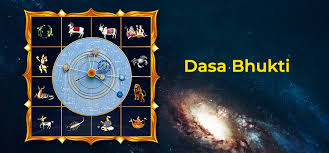Bhukt and Bhogya Dasha in Vedic Astrology
In Vedic astrology, the concepts of Bhukt Dasha and Bhogya Dasha are used to determine the elapsed and remaining planetary periods within the Vimshottari Dasha system. These terms help astrologers analyze the timing of events and predict life changes based on planetary influences.
1. Bhukt Dasha (Elapsed Dasha)
- Definition: Bhukt Dasha refers to the portion of a planetary Mahadasha that has already passed at the time of birth.
- Calculation: It is determined based on the Moon’s position in a Nakshatra at birth.
- Significance: The effects of the Bhukt Dasha influence early life experiences and set the foundation for future planetary periods.
2. Bhogya Dasha (Remaining Dasha)
- Definition: Bhogya Dasha represents the remaining duration of a planetary Mahadasha that will be experienced after birth.
- Calculation: It is derived by subtracting the Bhukt Dasha from the total duration of the Mahadasha.
- Significance: Bhogya Dasha determines the upcoming influences of planets and helps predict major life events.
Example Calculation:
If a person is born with the Moon in Venus Nakshatra, their Mahadasha starts with Venus (20 years).
- If the Moon has already traveled 50% of the Nakshatra, then:
- Bhukt Dasha = 10 years (elapsed)
- Bhogya Dasha = 10 years (remaining)
This calculation helps astrologers determine the starting planetary period and predict the effects of upcoming Dashas.
Importance in Predictions:
- Bhukt Dasha influences early life experiences and past karma.
- Bhogya Dasha helps forecast future events, career growth, relationships, and spiritual progress.
- Both are crucial for timing major life changes and understanding planetary transitions.




